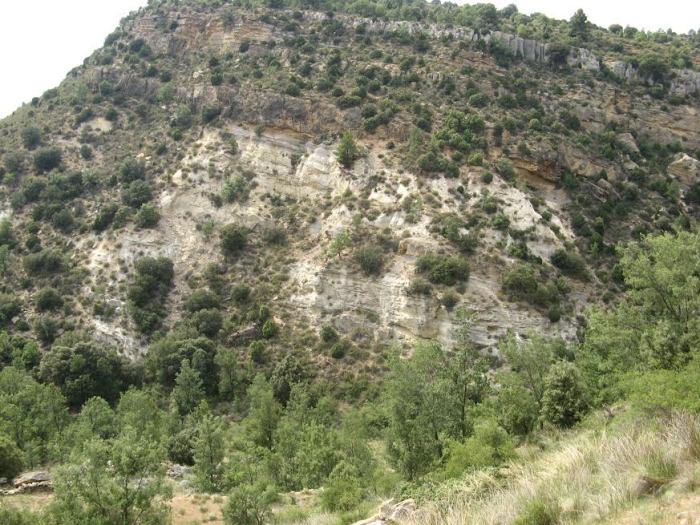
This new painting it’s the first price winner of the illustration contest: “Viajando a tiempos pretéritos”, organized by the “Geodivulgar Group”, from the Complutense University of Madrid.
For the contest I had to draw a Miocene continental landscape, so I choose to reconstruct a fossil site in which I had worked before, the Somosaguas Site, in Madrid (Middle Miocene – 14 Ma). I tried to show three main features of this miocene landscape: Geology, flora and fauna.
Geology
In the Somosaguas fossil site there are three different strata, only two of them contain fossils. For the painting I choose to represent the only one with a mega-faunal assemblage, the uppermost-strata (T3, in the papers) (Hernández Fernández, et al., 2006). This layer has been interpreted as the distal part of an alluvial fan, this fan would see the formation of small ephemeral lake systems. Knowing this, I looked for pictures of alluvial fans, mainly from the Death Valley, in order to draw a similar morphology in the background of the drawings. For the mountains I painted a slightly different version of the familiar Madrid´s granitic range.
Flora
The fossil-bearing layer in the Somosaguas fossil site represents a Savanah biome, in a tropical semi-arid climate with a strong seasonality. Thanks to palynologycal analysis from various Middle Miocene sites in Madrid (Fernandez-Marrón, et al., 2004), we know that the granitic mountains were covered with Pinus, Tsuga, Fagus, Zelkova and Ilex. For the painting I focused mainly on the pine trees, maybe under the influence of the current look of this mountain range.

The vegetation in the alluvial fan would have been xeric, forming open grassland with small shrubs such as Podogonium (Miocene Fabaceae), Pistacia, Robinia, Ephedripites, Asteraceae, Ericaceae and grasses (Poaceae).
Close to the small ponds some form of riparian vegetation could develop, mainly Salix, Carya, Alnus and Daphnogene.
Fauna
This fossil site provides paleontologists in Madrid with fossils from a very complete Miocene faunal assemblage. The principal components are Gomphotherium angustidens, Anchitherium sp, Prosantorhinus douvillei (among others). The carnivores are represented mainly by Hemicyon and the great Bear-Dog: Amphicyon. Also, thanks to a very extensive work carried out mainly by students, lots of microvertebrate fossils have been found in the sediment range (Hernández Fernández, et al., 2006).
In contrast to a very extensive faunal list, the painting here seems to be a bit empty. I wanted to focus mainly on the landscape and thus I paid a lot of attention to the sky, mountains and background. The only animals represented in the picture are a small herd of Gomphotherium angustidens, drinking from the small ponds that would form in the distal region of the alluvial fans during the wet season. The Gomphotherium is usually advertised as the face of the Somosaguas site, and their size (more than 3m height) would have made them a landscape feature more than anything.
By combining these three features I hope to have created a faithful reconstruction of Madrid’s landscape during the 14 million years ago.
Fernández Marrón, M.T., Fonollá Ocete, J.F. Sesé Benito, C. & Jiménez Rodrigo, J.C. Estudio paleomabiental de nuevos yacimientos de plantas y vertebrados de la “Unidad Intermedia” del Mioceno Medio de la cuenca de Madrid. Revista Española de Paleontología, 19, 2, 199-213.
Hernández Fernández, M., Cárdaba, J.A., Cuevas-González, J., Fesharaki, O., Salesa, M.J., Corrales, B., Domingo, L., Elez, J., López Guerrero, P., Sala-Burgos, N., Morales, & López-Martínez, N. 2006. Los yacimientos de vertebrados del Mioceno medio de Somosaguas (Pozuelo de Alarcón, Madrid): implicaciones paleoambientales y paleoclimáticas. Estudios Geológicos, 62, 1, 266-294.









